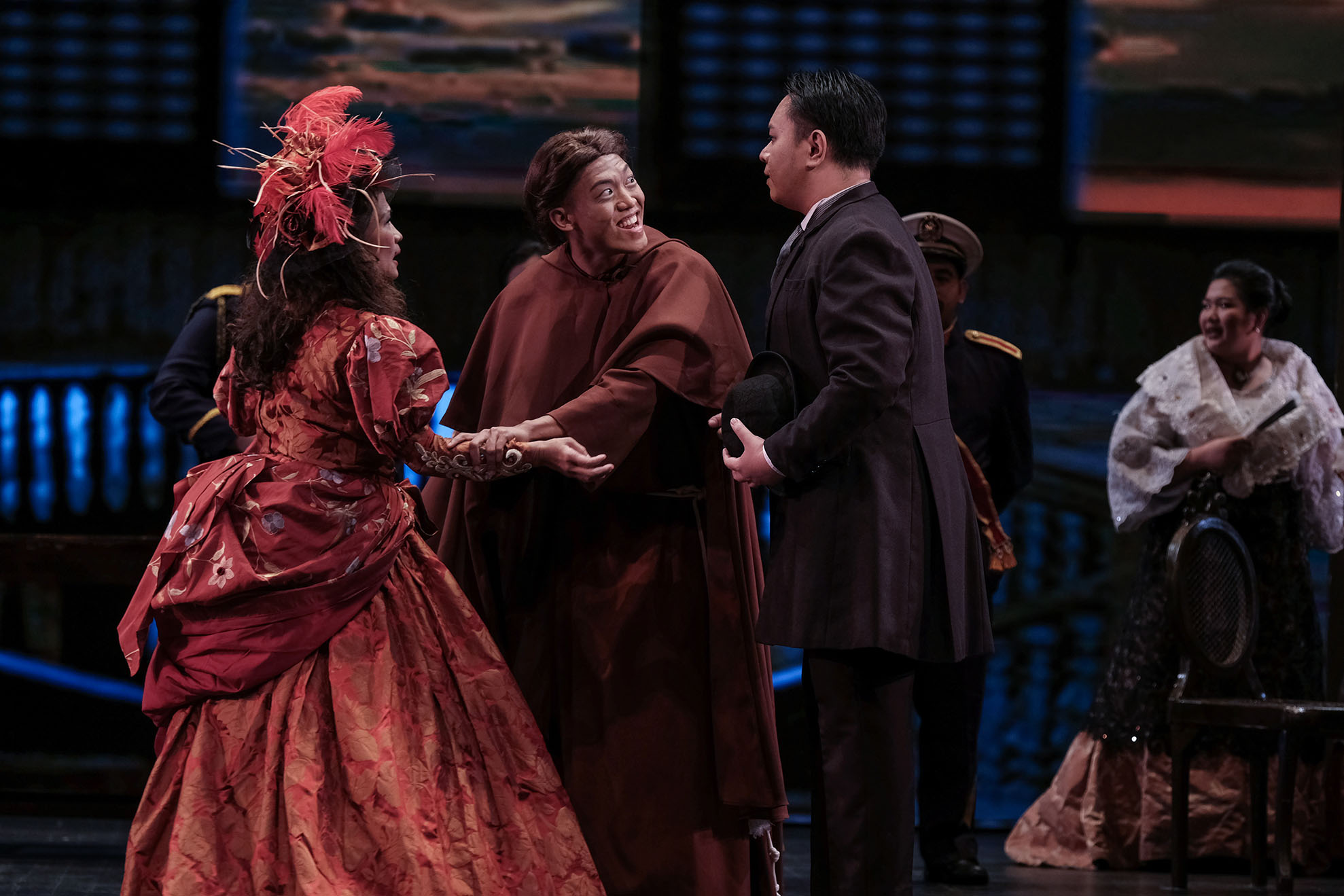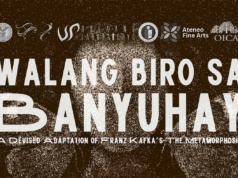
March 8-10, 2019
Tanghalang Nicanor Abelardo
Cultural Center of the Philippines, CCP Complex, Roxas Boulevard, 1300 Pasay City, Philippines
Don’t miss out on the all-new production of the acclaimed Filipino opera, NOLI ME TANGERE, back at the Cultural Center of the Philippines (CCP), March 8-10 only! It’s a grand tribute to National Hero Dr. Jose Rizal, National Artists Felipe de Leon and Guillermo Tolentino in time for the 50th anniversary of the CCP!
Performances: March 8 (Fri-Gala), 8 p.m., March 9 (Sat.), 2 p.m., and March 10 (Sun), 2 p.m.
New Ticket Prices: (VAT inclusive):
March 8, 2019, 8PM Show
Orchestra Center – P3,500
Orchestra Side/Parterre – P2,800
Balcony 1 Center – P1,500
Balcony I Side – P1,200
Balcony II Center & Side = P1,000
March 9 & 10, 2019, Matinee 2PM Show
Orchestra Center – P2,800
Orchestra Side/Parterre – P2,300
Balcony 1 Center – P1,400
Balcony I Side – P1,200
Balcony II Center & Side – P900
50% off for students, 20% discount for senior citizens, PWD, government and military personnel
Get those limited seats at 0947-168-1714, 0915-819-3459, or 02-998-2356! #NoliMeTangereOpera
The opera is performed with English supertitles.

The Story
ACT I
In the spacious sala of Kapitan Tiago’s house in San Diego, a reception is held to celebrate the return of Crisostomo Ibarra after a seven-year stay in Europe. Awaiting the arrival of the 22-year old student are the gobernadorcillo and his wife, Doña Victorina and Dr. Espadaña, Lt. Guevarra, and the Alferez, Padre Salvi, Padre Damaso and other friends.
Transferred by the government to a distant town, Padre Damaso denounces the character of the native Filipino derisively, called Indio, while Padre Salvi calms him down. Padre Damaso attacks the gobernadorcillo’s interference in local affairs, such as exhuming the body of an unbeliever and denying it Christian burial (Ibig kong sabihin).
Accompanied by Kaptain Tiago, the much-awaited honoree arrives amidst a heated conversation among the visitors. Unaware of what has happened prior to his arrival, Ibarra eagerly approaches Padre Damaso, only to be rebuffed.
The sudden death of Ibarra’s father continues to puzzle the young man as he confides in Don Filipo. Only the news that Tia Isabel and Maria Clara are expected soon mitigates Ibarra’s deep thoughts. He announces plans to build a schoolhouse to honor his father’s memory. The guests move to the dining room for supper as Tia Isabel and the shy nineteen-year old Maria Clara arrive. Ibarra rushes to welcome them. The lovers left alone can now reminisce on sweet memories spent together. (Malilimot kita?) (Natatandaan mo).
Act One closes with the lovers in a huddle, Ibarra still pondering the death of his father. Saddened by this thought, he begs leave to pay respect at his father’s grave. Maria Clara feels a premonition of disaster.

(Photo by Mark Francis)
ACT II SCENE I
It is All Saint’s Day and the people of San Diego are on their way to the local cemetery. Tasyo meets Basilio and Crispin enroute to town to ring the church bells, as storm warning. He cautions them to stay away from the bells during lightning flashes and tells them to come home early.
Two grave diggers rest from their day’s labors; one of them brags of a stormy night when he exhumed a body. At this point, Ibarra, enters and inquires about the location of his father’s grave. The old gravedigger replies that he was ordered to dig the body and bury it in another spot, which enrages Ibarra. When asked to locate the new grave, the worker answers that he disobeyed orders and threw the body into the lake. Ibarra lunges blindly at the gravediggers and exits in a frenzy.
The shadows of evening deepen; lightning flashes and the rumble of thunder presage a fast coming storm. Pilosopo Tasyo watching the elements is engaged in conversation by the gobernadorcillo; sarcasm marks Tasyo’s words with stupid rejoinders from the latter. A loud thunder clap scares the gobernadorcillo away as the rains start to fall.
Confusion arises when Crispin is suddenly accused of theft and gets detained in the convent. Anxious to tell their mother Sisa, Basilio rushes home but is shot in the leg. Meanwhile, Sisa is also accosted by the guardias civiles. Shocked and protesting innocence, she breaks down in pitiful whimper for her lost children.
Pilosopo Tasyo records his observation about the elements in an ancient book. Focus turns to Ibarra who seeks counsel from Pilosopo Tasyo. The latter advises the youth to “bend your head with the storm” like a bamboo (Hindi isang karuwagan).

(Photo by Mark Francis)
ACT II SCENE II
The young people of San Diego gather at a picnic by the lake to celebrate Ibarra’s return. Maria Clara is prevailed upon to sing. She replies that all her songs are sad and she sings of the sweet hours on one’s native land (Kay tamis ng buhay).
Meanwhile, the fishermen report on no catch because of the presence of a crocodile in the coral. Elias a woodsman, tries to drive away the crocodile but is endangered. Ibarra goes to save Elias. Their return unscathed relieves the crowd’s suspense.
Later, the two young men are left alone with Kapitan Tiago and Don Filipo. Elias thanks Ibarra for saving his life and cautions him to beware of his enemies (Alam ko ang buhay). Reminding Ibarra about life’s conflicts, the two exchange ideas and ideals. Lamenting her lost children, Sisa then wanders by. Elias assists the poor demented woman.
While Ibarra elaborates on his dream of building a school house in his father’s memory for the rural folk (Aking itatayong paaralan). Padre Damaso joins the conversation and ridicules Ibarra’s plans, calling it a scheme of a viper (Lahat sila’y magtatapos). Enraged, Ibarra snatches a knife and lunges at the priest. Only the timely interference of Maria Clara appeases the young man.

(Photo by Mark Francis)
ACT III SCENE I
Maria Clara depressed and sick has retired to her bedroom. Ibarra had been banished from San Diego. Her Tia Isabel and friends Sinang and Andeng try to console her.
Kapitan Tiago enters and reports in woeful tones about his vain intercession with Padre Damaso who has ordered the breaking of the marriage agreement between Maria Clara and Ibarra, having in mind his own relative, Alfonso Linares, a Spanish youth, for Maria Clara.
Night has fallen, Doña Victorina and Padre Damaso eagerly plan the meeting of Maria Clara and Linares who shyly accepts the marriage agreement.
Ibarra meanwhile has talked to the governor-general (Sa Maynila po bunying gobernador) and is now in the good grace of the authorities. Thrilled with the new developments, he visits Maria Clara and proposes marriage. She sings of the pure and holy love she brings to the man she will marry. (Banal ang pagibig). The rejoicing of the couple and household of Kapitan Tiago is interrupted by the arrival of the Alferez who has come to arrest Ibarra for allegedly having been implicated in an uprising. Maria Clara in great despair calls the aid of her Heavenly Mother (Aba Maria). A conflagration is seen through the closed window.

(Photo by Mark Francis)
ACT III SCENE II
In her bedroom, Maria Clara is worried over the fate of Ibarra, but Padre Damaso consoles her (Diyos ko, bakit inilayo mo……) and discourages the young girl from her plan of entering the convent. In a dramatic duet (Ibig ko pang makalibong) he makes her understand the hardships of cloistered life. Aware of the firm determination of Maria Clara, Padre Damaso leaves her, feeling abjectly defeated and wounded to the core as he resigns his will to the inescapable ways of God. (O Diyos na makapangyarihan).
On the floor, Maria Clara implores the Heavenly Mother to restore her lost love. A familiar shadow appears from her window. Aided by Elias, Ibarra has just escaped from prison and visits Maria Clara. He pours bitter reproaches (Aking sinumpaan) upon the girl for her rumored marriage to Linares. Explaining her plight, (Di mo lang nalalaman) Maria Clara says that to save her mother’s honor she has consented to the marriage after discovering that her real father is… muffledly sobering his name to Ibarra. She cries out that although forced to marry another, her heart will always belong to him (Mahal Kong Crisostomo).
In their final duet, (Sa lupang pangako) they dream of life away from pain and anguish. Recalling that he is an escaped prisoner. Ibarra reluctantly leaves through the window. Maria Clara hears the voice of a guardia civil. Two gunshots follow, as she sees her lover shot beneath her window. She prays and appears like a forlorn figure in a silent cloister.

(Photo by Mark Francis)
ACT III SCENE III
A gloomy atmosphere permeates the last scene. Sisa emerges dangling a crude old doll. Confused, she rests on a tombstone wailing her haunting refrain. In Ganyang ganyan ang bulaklak ng buhay she sings how like a flower is the life of a woman. Meanwhile, weary and crippled by the festering wound in his leg, Basilio stalks in and approaches his mother Sisa, who is unable to recognize him. He unsuccessfully continues to chase her until he falls asleep in sheer weariness.
A stab of recognition flashes through Sisa’s muddled mind as she beholds and embraces Basilio. But the shock is too much for her exhausted heart and clawing at the tomb for support, she finally expires.
Mortally wounded, Elias staggers in and instructs Basilio to build a pyre to burn both his (Elias) body and Sisa. He gives Basilio a reward of a cache of hidden gold and entreats the boy to use the money for his schooling. The boy gathers kindlings and Elias gasps out his last breath (Mamamatay akong di makikita), intoning that he dies “without seeing the dawn”, enjoining those left behind to remember the many who have fallen in the starless night, that others may live in freedom. The faint light of dawn touches Elias’ noble face as he goes to his final rest.

(Photo by Mark Francis)
Facts
“Noli Me Tangere, The Opera,” written in Three Acts by National Artists Felipe Padilla De Leon (music) and Guillermo Tolentino (libretto in Tagalog), is the Philippines’ first full-length opera whose orchestral arrangements were influenced by kundiman and the Western classical music tradition.
Based on Dr. Jose Rizal’s 1887 novel of the same name, premiered at Far Eastern University (FEU) in 1957.
The opera made its Cultural Center of the Philippines (CCP) debut in 1974.
The opera was restaged at the CCP in 1987, led by soprano Fides Cuyugan-Asensio’s Music Theater Foundation.
The CCP and J&S Productions Inc. presented the 60th-anniversary production of the opera at the CCP’s main theatre, Tanghalang Nicanor Abelardo, in 2017.
Prior to the 60th-anniversary production of the opera at the CCP, J&S Productions premiered the opera at the Kaye Playhouse in New York City in 2013. The production also played at the John F. Kennedy Center for the Performing Arts in Washington D.C. in 2014 and at Resorts World Manila in the same year.
Felipe Padilla de Leon, the opera’s composer, wrote the popular Tagalog Christmas carol “Payapang Daigdig” in 1946, during the Japanese invasion of the Philippines.
Besides this operatic adaptation of Dr. Jose Rizal’s landmark novel, “Noli Me Tangere” has also been adapted into film, television, comic books, musicals, and plays. It is mandated by law to study Dr. Rizal’s life and works in high school and college.


















